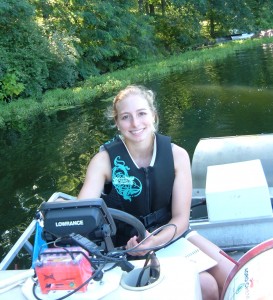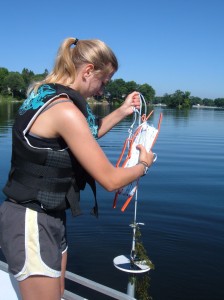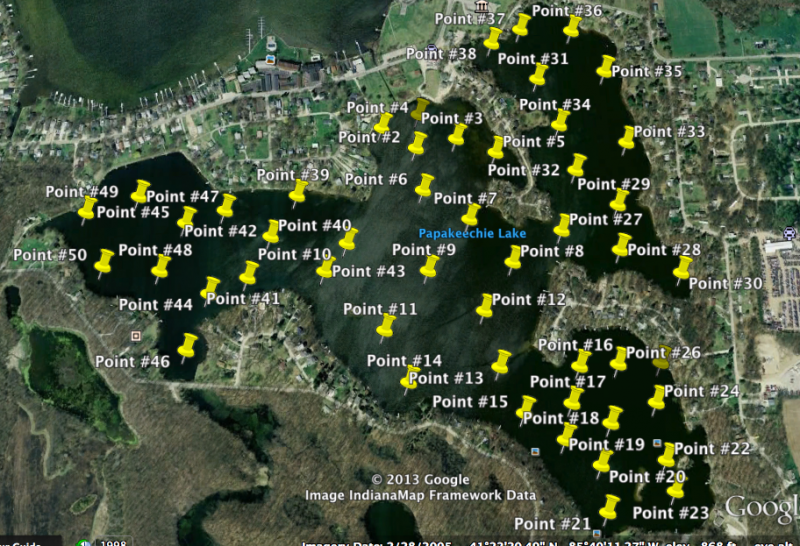Grant Used For Papakeechie Water Testing
By VIRGINIA SURSO

Hannah Becker drives the PPA boat on her rounds to test water at 50 GPS locations on Lake Papakeechie. The boat, normally used to add chemicals to the lake for weed control, is a small pontoon powered by a paddle wheel.
A research grant from the University of Notre Dame gave Hannah Becker of Zionsville an opportunity to test the quality of the water in Lake Papakeechie this summer.
She spent hours on the lake testing 50 GPS locations for turbidity (water clarity), levels of dissolved oxygen, water temperature and E. coli. She wrote protocols for specific water tests and for the calibration and use of specific scientific equipment involved in the tests.
The DaVinci Grant given by the Institute for Scholarship in the Liberal Arts at Notre Dame also required a sociological component to the project. To that end, she developed a questionnaire and interviewed residents on lakes Papakeechie and Wawasee to learn of their environmental concerns and of differences they see in water quality today compared to when they moved to the lakes region, in some cases over 70 years ago.
She still needs to analyze the data she collected and write a two-part report required by the DaVinci Grant.
The project is part of the Lake Papakeechie Sustainability Initiative, the environmental arm of the Papakeechie Protective Association. Dr. Anthony Serianni, professor of chemistry and biochemistry at ND, coordinates the program.
The lake tests conducted by Hannah were chosen by LAPSI as most critical in an initial determination of water quality on Lake Papakeechie and in assessing what steps might be needed to be taken in the future.
 The turbidity test evaluates water clarity, which is determined in part by the amount of particulate matter suspended in the water. Dissolved oxygen and temperature are important indicators of the ability of the lake to support aquatic life. D.O. and T were measured as a function of lake depth in one-meter and at the end in 1/10th of a meter increments at 50 GPS sites on the lake.
The turbidity test evaluates water clarity, which is determined in part by the amount of particulate matter suspended in the water. Dissolved oxygen and temperature are important indicators of the ability of the lake to support aquatic life. D.O. and T were measured as a function of lake depth in one-meter and at the end in 1/10th of a meter increments at 50 GPS sites on the lake.
Escherichia coli (E. coli) is a rod-shaped bacterium that lives in the lower intestine of warm-blooded animals. High levels of E. coli make lakes, rivers and streams unsafe for human lake activities and can cause infections. The presence of E. coli in water is an indicator of animal decay, faulty septic or sewer systems and/or wild animal feces. Readings in excess of 235 CFU (colony-forming united) per 100 m of water make the water unsafe for swimming. Levels below 135 are considered safe.
Hannah arrived at Lake Papakeechie just in time for July 4 activities and will return to Notre Dame next week to begin her junior year of studies with a major in anthropology and a minor in sustainability, the capacity of the eco-system to endure and continue to remain diverse over time. Ultimately, she would like to become an attorney that specializes in environmental policy and law.
She explains, “The sociological part of the grant investigates the actions and attitudes of lake residents since they ultimately decide by their actions how healthy the lake will be.”

